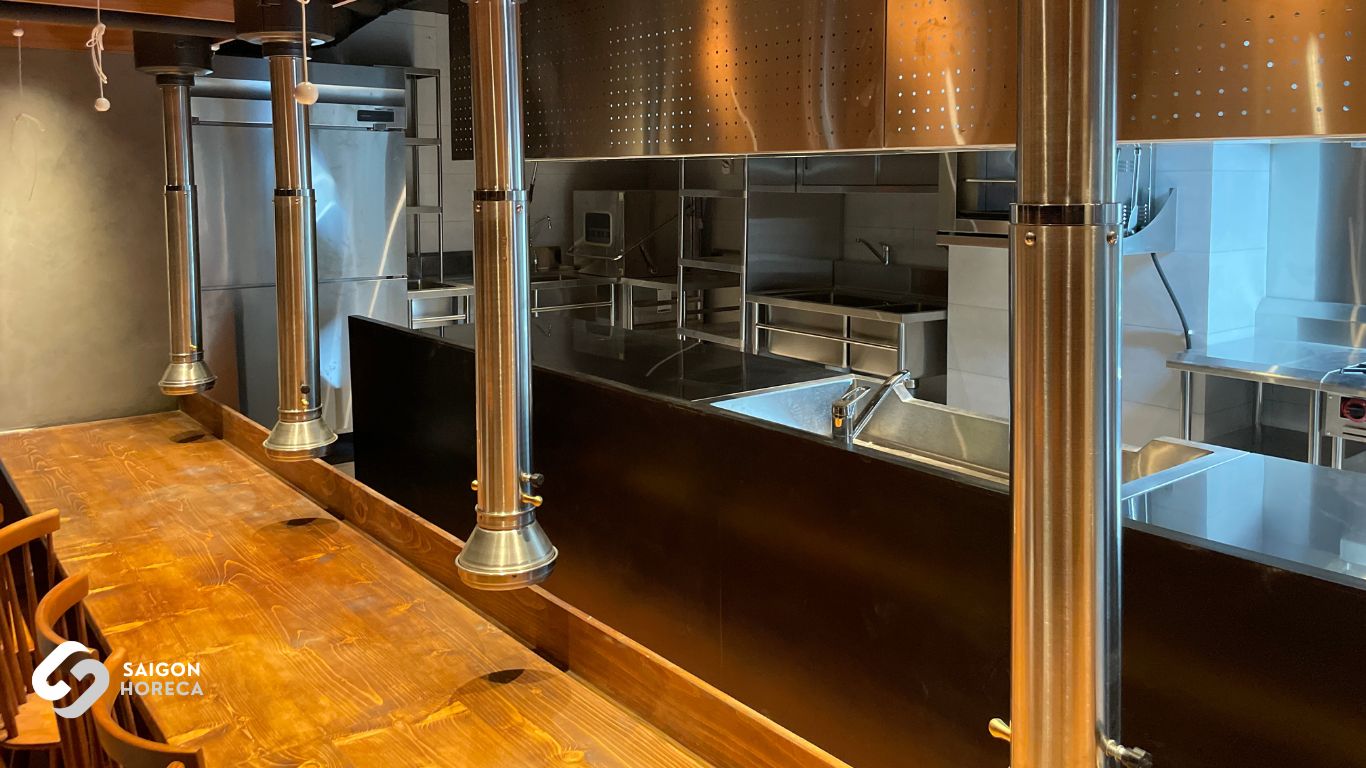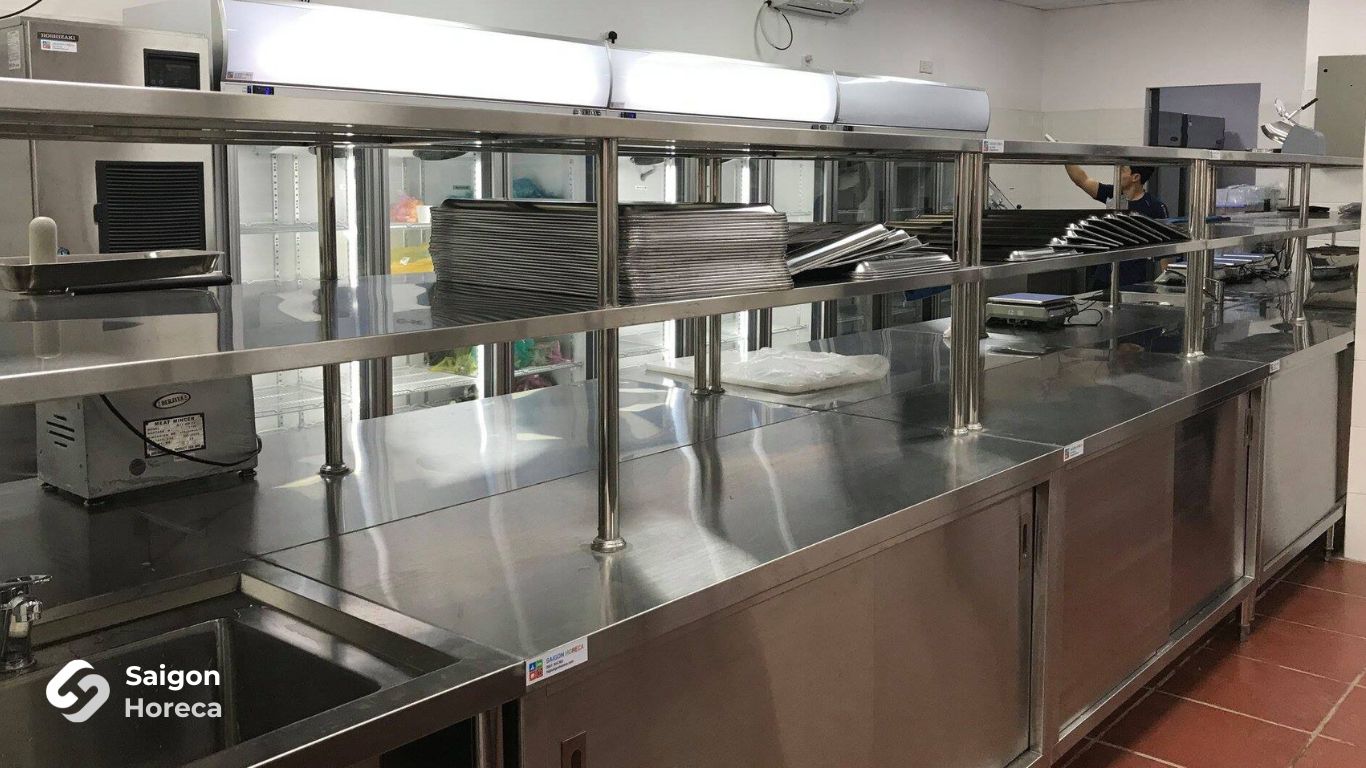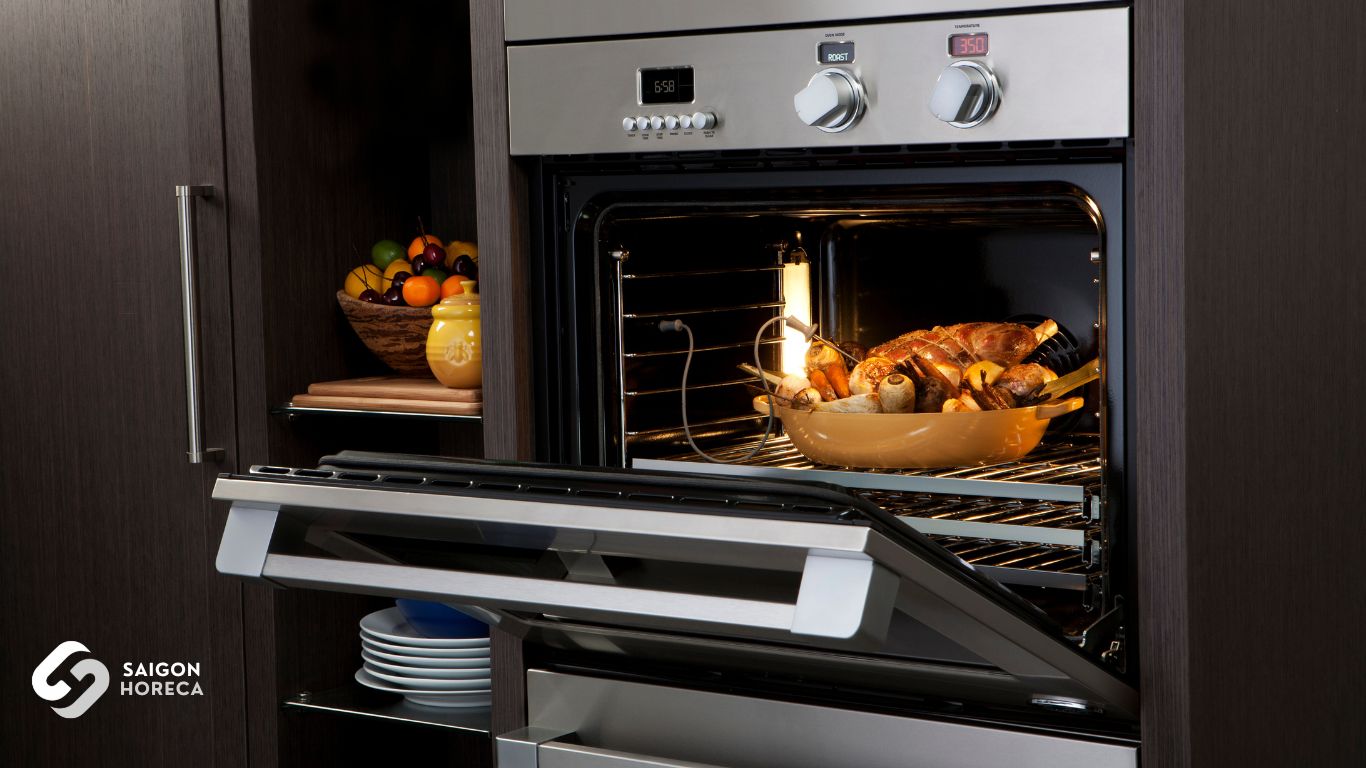In the context of the rapidly growing culinary and food service industry, investing in industrial kitchen equipment for a canteen […]
Read more

- News
Japanese Restaurant Kitchen Design – Balancing Technique, Aesthetics & Service
- June 27, 2025
The Japanese restaurant kitchen is not only a place to prepare food but also a space that reflects the sophisticated cultural values of the land of Phu Tang. Every detail in the design represents meticulousness, from the layout of the space to the selection of materials and equipment, all of which serve a single purpose: optimizing the work and creating an efficient, yet aesthetically pleasing, workspace.
With current trends, Japanese restaurants are increasingly focusing on designing the kitchen to be both beautiful and convenient. The kitchen space not only helps chefs work quickly and accurately, but also honors the sophistication of each dish. Therefore, kitchen design for Japanese restaurants requires a harmonious combination of functionality and simple beauty, reflecting the true cultural identity of Japanese cuisine.
In this article
Why is Japanese restaurant kitchen design important?
With the strong development of the Japanese culinary industry in Vietnam and other countries, restaurant owners are gradually realizing that an efficient and stylish kitchen design creates a great culinary experience, both saves time and improves service quality.
Every Japanese restaurant has specific requirements, from raw material preservation to processing process, and a suitable kitchen design. Therefore, designing a Japanese restaurant kitchen requires a deep understanding of technical factors, while also grasping Japanese cultural identity in every detail. Saigon Horeca with extensive experience in designing kitchens for Japanese restaurants has brought optimal solutions, from outstanding projects such as Yakiuo Ishikawa Saigon, Yuzu Omakase, to Heiwa Sushi, each project has its own unique characteristics.
1. Spirit and culture in Japanese cuisine
Japanese cuisine not only focuses on fresh ingredients but also requires meticulousness and precision in each processing stage.
Each Saigon Horeca project is designed to protect ingredients and preserve the typical flavor of Japanese cuisine. At Yuzu Omakase, the design of food preservation systems such as specialized refrigerators and cold counters to preserve ingredients helps maintain the freshness of fish and seafood –, indispensable ingredients in sushi dishes and sashimi. These elements ensure that the dish is always prepared with the freshest ingredients, preserving its flavor.
2. Space optimization and work efficiency
A reasonable kitchen space, with a reasonable division between functional areas, will help chefs operate more easily and quickly, thereby improving productivity and minimizing clutter.
At Heiwa Sushi, the kitchen space is designed to be expandable and easily viewed from the bar. The high-end wooden bar with transparent glass not only creates a connection between customers and chefs but is also an aesthetic highlight, helping diners directly follow the dish preparation process.
3. Cost-saving and sustainable
A good kitchen design not only helps optimize functionality but also saves long-term operating costs. Choosing energy-saving kitchen equipment, using materials that are easy to maintain and improve performance is an important factor to protect the environment and reduce restaurant costs.
The Yakiuo Ishikawa Saigon project is a typical example when Saigon Horeca chooses energy-saving and easy-to-maintain kitchen equipment such as Hoshizaki freezers and specialized smoke extraction systems, helping to minimize operating costs but still ensure maximum efficiency. The smoke extraction system is delicately designed, not only helping to keep the kitchen space clean but also ensuring that customers’ dining space is not smelly.
4. Create a comfortable and flexible space for the chef
Chefs need a comfortable kitchen space that is spacious enough for them to be productive without restrictions. Kitchen design needs to ensure flexibility in each processing stage, from preparing ingredients to perfecting dishes.
At Yuzu Omakase, Saigon Horeca has created a spacious and airy kitchen space, helping chefs easily move between processing areas without getting entangled. Streamlined kitchen appliances, from grills to refrigerators to stainless steel utensils, are all designed to ensure that there aren’t any interruptions in the processing process. This helps chefs focus on creating sophisticated, Omakase-style dishes.
5. Impress and attract customers
An open kitchen space where customers can directly monitor the food preparation process. This extremely special design not only attracts guests but also brings a special culinary experience.
At Heiwa Sushi, the bar is designed near the kitchen, creating a relaxing space while still maintaining intimacy. The gentle yellow light combined with high-quality wood and transparent glass helps customers watch chefs prepare dishes right in front of them.
Saigon Horeca’s Yakiuo Ishikawa Saigon, Yuzu Omakase, and Heiwa Sushi projects have shown attention to detail in Japanese restaurant kitchen design. Each project is a testament to the perfect combination of features, performance and aesthetics, helping to optimize workflows, save costs and provide a comfortable space for both chefs and customers.








Japanese cuisine and the need for specialized kitchen design
Japanese cuisine is no longer strange to Vietnamese diners. From signature dishes like sushi, ramen, to omakase and izakaya – each style brings with it its own philosophy of neatness, minimalism and respect for ingredients. But for those values to be fully present in each dish, the first factor that needs to be seriously invested in is not the – dining table but the kitchen space.
In the Kitchen space for Japanese cuisine, fresh ingredients – like sashimi or bluefin tuna – require stable storage temperature, standard cooling system. Grilled dishes such as yakitori or yakiniku require an effective smoke extraction system. Even the preliminary area must be designed separately, ensuring hygiene while still optimizing the chef’s movements and operations.
All equipment, from high-capacity gas stoves, specialized sinks to storage systems, needs to be scientifically arranged, suitable for specific operating procedures. For example, in omakase – where the chef performs live in front of guests –, the neatness and sophistication of the kitchen design not only supports operations but also contributes to shaping a classy culinary experience.
One thing that is often forgotten, but is extremely important: kitchen design also needs to “sympathize” with culinary style. The kitchen for izakaya needs to be flexible, serving many small dishes at the same time. The ramen stove focuses on the area where broth is cooked, noodles are preserved and toppings are stored. A standard model cannot be applied to every – style but needs a “tailored” design based on the menu, space and philosophy of the restaurant.
Choosing the right kitchen design is laying the foundation for food quality. It’s not just a technical story, but an investment in a – long journey where every detail in the kitchen contributes to the spirit of Japanese cuisine.


Japanese restaurant kitchen design thinking: Minimalist but effective
Unobtrusive Japanese cuisine – and so is the Japanese kitchen.
A Japanese restaurant may not need too large an area, but it does require an extremely scientific kitchen design where every detail is carefully considered to cater for a smooth “one flow” operating line: from receiving ingredients, pre-processing, processing to serving. There is no room for a surplus of – just what is needed, but must be accurate and efficient to the centimeter.
Japanese kitchen design philosophy puts the chef at the center. Space, equipment, lighting – are all calculated to support maximum operations of the chef and team. The stove must be clean, easy to clean, and accessible. There are no extra details, no “devices to that for beautiful”. Everything must serve function and speed.
Open kitchen – is not just an aesthetic trend, but part of the omakase spirit: where the chef is not simply a cook, but a performance artist. From cutting sashimi, grilling fish, blowing fire or simply stacking dishes on a – plate are all part of the experience. Therefore, the kitchen design must be clean, airy, compact and beautiful – so that guests can enjoy the dish with both taste and sight.
In some specific models such as yakiniku or izakaya, the kitchen design also needs to be flexible and interact a lot with guests. Smoke extraction and fresh air supply systems, mini cold storage areas, or streamlined yet accessible wardrobes are factors that help restaurants operate efficiently without losing the intimacy inherent in Japanese cuisine.
Specialized equipment for Japanese restaurants – Small but refined
Japanese cuisine has always required near-absolute precision in every slice, raw freshness of ingredients, and clean, coherent kitchen operations. Therefore, the Japanese kitchen space is indispensable for equipment that is optimal for the process, and at the same time lean for both efficient operation and aesthetic retention.
At Saigon Horeca, we not only provide equipment, but also synchronously design the Japanese kitchen system based on practical experience from the – chef team so that every step from preparation to service is smooth, clean, and saves every square meter of space.
Below are the outstanding items implemented in the Japanese restaurant projects we carry out:
- Six-burner European kitchen in premium 304 stainless steel – is flexible for many cooking styles in omakase or izakaya spaces.
- Super large custom sink, serving specifically for preparing ocean tuna – with high-quality ingredients commonly found in traditional sushi models.
- Specialized dry incubator for Japanese bluefin tuna – is one of the important factors to ensure deep sweetness and standard meat structure.
- Hoshizaki freezer and high-end cold storage equipment, keeping fresh raw materials quality throughout operation.
- Tailor-made fresh air intake and air supply system, ensuring an open, odor-free working environment – is especially important in Japanese kitchens, where it is often small in scale and served directly.
- High-end table smoke extraction system, can customize height and flow, combined with – separate oil separator filter to help the diner experience not be interrupted by odors or smoke haunt.
- 304 stainless steel ceiling cabinet system, streamlined design, ensuring hygiene and taking advantage of vertical space – is an optimal choice in small kitchen models such as ramen shop or izakaya.
The collaboration with Heiwa Sushi is a typical example. With understanding the technical requirements of Japanese kitchens, Saigon Horeca has provided all modern stainless steel rack systems, along with imported Japanese standard freezers, contributing to helping the kitchen space here fit beautiful – standard – effective.


Experience designing industrial kitchens in the Japanese business environment
Typical project: Nichiyo company canteen – Long Hau Industrial Park Not a restaurant, but the canteen project at Nichiyo –, a 100% Japanese business, sets standards as strict as professional culinary chains.Japanese kitchen standards in corporate environments
Despite internal service, Nichiyo still requires:- Closed kitchen process magnetic raw material reception – pre-processing – cooking – washing, no corner cutting.
- HACCP food safety – from space layout to food contact material selection.
- Separate grease and waste treatment system, ensuring no odor generation, no impact on the industrial park environment.
Solution from Saigon Horeca: Compact, urgent, but not urgent
Under pressure of short construction time and limited investment budget, Saigon Horeca has:- Design of 1-way kitchen system according to HACCP standards, but still flexible according to actual premises.
- Clear separation preprocessing area – hot stove – washing area, limited crossings.
- Install industrial gas stove equipment, meal hot cabinets, and specialized deodorizing suction systems for medium-scale stoves.
- Deploy solution for grease treatment at source, through 304 stainless steel grease trap, easy to disassemble and clean periodically.


Why should you choose Saigon Horeca for Japanese restaurant projects?
Japanese cuisine is not simply a – dish but a standard of process, sophistication and precision. Therefore, designing a kitchen for a Japanese restaurant requires a partner who not only has experience, but also truly understands the culture and operating mindset of the Japanese.
- Saigon Horeca has directly implemented many different models. Diverse experience – from high-end omakase to large-capacity industrial kitchens
- Omakase, where every detail in the kitchen must achieve high perfection, both ensuring performance and maintaining aesthetics for the “demonstration space”.
- Industrial kitchens for Japanese businesses (like Nichiyo) with strict HACCP requirements and processes.
- Specialized design thinking for each model. No “one blueprint applies to all”. Each project is Saigon Horeca:
- Survey chef operating details, from processing to travel habits.
- Optimizes each centimeter of space, suitable for both small premises and large technical requirements.
- Ensure kitchen operates smoothly, cleanly, clearly subdivided, in accordance with Japanese standards.
- Understanding Japanese culture and technical standards: Working with Japanese investors is a journey that requires patience, diligence and absolute precision**.
Saigon Horeca is confident thanks to:
- Understand closed operating procedures, strict hygiene requirements and standards such as HACCP.
- Experience in direct coordination with operations managers, Japanese chefs – understand their language and working style.
- Proactively propose optimal solutions both technically and budgetally, without affecting operational quality.
From standard Japanese meals for 10 omakase diners, to 500 industrial meals per day, Saigon Horeca is designed with the same philosophy: Deep understanding – Making standard – Long-term attachment
Looking to elevate your grilled dishes with a Salamander Grill? With its ability to grill quickly and evenly while giving […]
Read more
Thứ hai - Thứ sáu
từ 8h00 đến 18h00
Số 40 Đường số 6, KDC Melosa Khang Điền, Phú Hữu, HCM.
Liên hệ ngay





